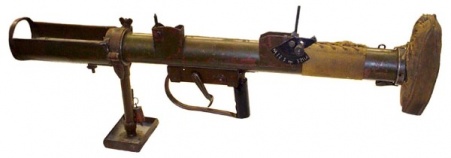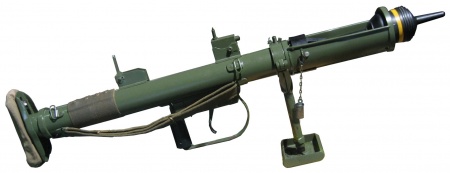| If you have been locked out of your account you can request a password reset here. |
Difference between revisions of "PIAT"
| Line 5: | Line 5: | ||
The weapon used a large coil spring fired spigot cocked by rotating and pulling back on the padded buttplate and then rotating it back and sliding it forward, which was used to ignite the bomb's primer and thus the propellant charge. This generally required the user to brace the buttplate with both feet and pull the rest of the weapon upwards. On firing, the force of the recoiling spigot was supposed to re-cock the spring; however, under battle conditions this mechanism frequently failed to function, forcing the weapon to be manually cocked after each shot. Practical rate of fire in combat was roughly 2-5 rounds per minute for a two-man crew. | The weapon used a large coil spring fired spigot cocked by rotating and pulling back on the padded buttplate and then rotating it back and sliding it forward, which was used to ignite the bomb's primer and thus the propellant charge. This generally required the user to brace the buttplate with both feet and pull the rest of the weapon upwards. On firing, the force of the recoiling spigot was supposed to re-cock the spring; however, under battle conditions this mechanism frequently failed to function, forcing the weapon to be manually cocked after each shot. Practical rate of fire in combat was roughly 2-5 rounds per minute for a two-man crew. | ||
| − | While difficult to use due to the vicious recoil and sheer amount of force required to cock the action, the weapon was capable of throwing a two-and-a-half pound bomb with a HEAT warhead anything up to 330 yards. The weapon could be used effectively by an experienced crew, but was heavy (the 32-pound weight meant the gunner | + | While difficult to use due to the vicious recoil and sheer amount of force required to cock the action, the weapon was capable of throwing a two-and-a-half pound bomb with a HEAT warhead anything up to 330 yards. The weapon could be used effectively by an experienced crew, but was heavy (the 32-pound weight meant the average gunner did not even carry ammunition for his own weapon), inaccurate, had a progressively shorter effective range as German tank technology improved, and rushed wartime production resulted in many defective projectiles which failed to fire or detonate, or more dangerously would blow off their own tailfin when the propelling charge detonated and fire it with lethal force at the PIAT team. |
__TOC__ | __TOC__ | ||
Revision as of 12:41, 11 January 2018
The Projector, Infantry, Anti Tank (PIAT) was an unusual anti-tank launcher designed by British Major Millis Jeffries in 1941 as a replacement for the obsolete Boys anti-tank rifle, and issued to field units in 1943. The weapon was essentially a scaled-down version of the carriage-mounted Blacker Bombard: Jeffries had planned a smaller version, but the large high explosive charges the Bombard used proved ineffective when scaled down. Hearing about hollow charge technology, he decided it would be perfect for the weapon, and designed a shoulder-fired launcher using an adapted spigot mortar system to fire a shaped-charge warhead on a relatively flat trajectory. Thus, while the PIAT used a mortar mechanism, it was not a mortar per se and was closer to a grenade launcher in terms of application. Commonwealth forces in Italy did successfully employ the PIAT as a crude mortar by bracing the stock against the ground, though this was not an intended feature of the weapon and there are no figures available for its range when used this way.
The weapon used a large coil spring fired spigot cocked by rotating and pulling back on the padded buttplate and then rotating it back and sliding it forward, which was used to ignite the bomb's primer and thus the propellant charge. This generally required the user to brace the buttplate with both feet and pull the rest of the weapon upwards. On firing, the force of the recoiling spigot was supposed to re-cock the spring; however, under battle conditions this mechanism frequently failed to function, forcing the weapon to be manually cocked after each shot. Practical rate of fire in combat was roughly 2-5 rounds per minute for a two-man crew.
While difficult to use due to the vicious recoil and sheer amount of force required to cock the action, the weapon was capable of throwing a two-and-a-half pound bomb with a HEAT warhead anything up to 330 yards. The weapon could be used effectively by an experienced crew, but was heavy (the 32-pound weight meant the average gunner did not even carry ammunition for his own weapon), inaccurate, had a progressively shorter effective range as German tank technology improved, and rushed wartime production resulted in many defective projectiles which failed to fire or detonate, or more dangerously would blow off their own tailfin when the propelling charge detonated and fire it with lethal force at the PIAT team.
Specifications
(1942-1950)
- Type: Spigot mortar
- Length: 39 inches
- Weight: 31.70 pounds
- Muzzle Velocity: 450 feet per second
- Effective range: 109 yards (actual effective range typically less than 40 yards versus armour)
- Maximum range: 330 yards
- Calibre: 3.25 inch
- Capacity: 1 round
- Fire modes: Safe / Fire
- Crew: 2
The PIAT and variants can be seen in the following films, television series, video games, and anime used by the following actors:
Film
| Title | Actor | Character | Notation | Date |
|---|---|---|---|---|
| City 44 | Michal Meyer | "Pajak" | 2014 | |
| Never Say Never Again | Q Branch | 1983 | ||
| A Bridge Too Far | British Paratroopers | 1977 | ||
| Paper Tiger | David Niven | Mr Bradbury | 1975 | |
| The Longest Day | French Commandos | 1962 | ||
| Canal (Kanal) | Polish insurgents | 1957 |
Television
| Title | Actor | Character | Notation | Date |
|---|---|---|---|---|
| Blott on the Landscape | David Suchet | Blott | 1985 |
Video Games
| Title | Referred As | Notes | Release Date |
|---|---|---|---|
| Commandos 2: Men of Courage | "Bazooka" | 2001 | |
| Medal of Honor: Allied Assault | "PIAT" | 2002 | |
| Commandos 3: Destination Berlin | "Bazooka" | 2003 | |
| Darkest Hour: Europe '44-'45 | Can be reloaded by teammate | 2006 | |
| Company of Heroes | 2006 | ||
| World War II Online: Battleground Europe | 2011 | ||
| Karma Online | 2011 | ||
| Dino D-Day | 2011 | ||
| Company of Heroes 2 | 2013 |

